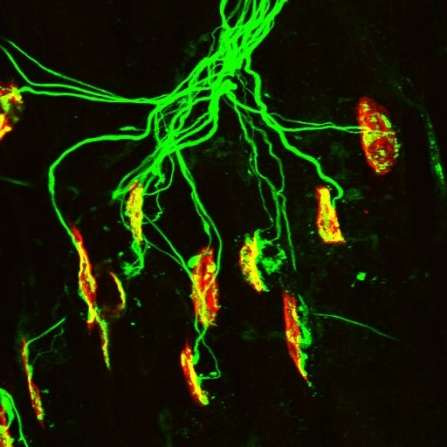Glutamate plays previously unknown role in neuromuscular development

For decades, scientists thought acetylcholine was the only neurotransmitter responsible for controlling how muscles and nerves are wired together during development.
Turns out, they were wrong. Glutamate, the most common neurotransmitter in the brain, is also necessary.
Researchers at the University at Buffalo and Johns Hopkins University reported their findings with mice in the Journal of Neuroscience.
The team took a new approach to the old question of how the connections from the spinal cord to the muscles mature, says Kirkwood Personius, the paper's lead author and a clinical associate professor of rehabilitation science in UB's School of Public Health and Health Professions.
Each muscle is made of many individual muscle fibers and, in adults, each of those muscle fibers is contacted by a single motor neuron. However, this simple arrangement is not what you see at birth. Instead, each muscle fiber is contacted by as many as 10 nerves.
The process that allows one motor neuron to stay while all the others are retracted seems to be this, according to the researchers: the nerve that's most effective in activating the muscle is the one that wins.
But what specifically occurs during the nerve's firing that triggers the stabilizing of the winner and the withdrawal of the others? For many decades, it was assumed that the pruning process began with release of the neurotransmitter acetylcholine from the nerve. This seemed logical, the paper's authors say, because motor neurons do indeed release lots of acetylcholine.
"However, we now have shown that an important transmitter is one that nobody had previously expected: it is glutamate," said Personius, PT, PhD. "The nerves release a molecule that is converted into glutamate, and the glutamate then activates glutamate receptors, notably NMDA receptors, on the muscle."
NMDA (N-methyl-D-aspartate) receptors are one of several types of molecules that respond to glutamate. They are especially important in the central nervous system controlling brain development, learning and synaptic plasticity. "Nobody thought NMDA receptors played any role in the innervation of muscle," Personius said.
The researchers tested their hypothesis—that glutamate receptor activation modulates the development of the neuromuscular system—in several ways, each of which supported what they thought. In addition, they showed that the response of the muscle to glutamate is very strong at birth, but quickly disappears as mice mature.
"Our work restarts a field that was stuck because of the widespread conviction that the process depended on a single transmitter, acetylcholine," said Susan Udin, PhD, a paper co-author and professor of physiology in UB's Jacobs School of Medicine and Biomedical Sciences.
"This study opens up a wide range of experimental possibilities because so much is known from central nervous system studies about how NMDA receptors work. Our work opens up a possible understanding of why return of muscle function is often limited after peripheral nerve trauma."
The same processes that control muscle fiber development tend to recur after peripheral injury in adults. Now, the research team is testing the hypothesis that the poor outcomes often seen after peripheral nerve trauma could be improved by manipulating NMDA receptors.
More information: K. E. Personius et al, Neuromuscular NMDA Receptors Modulate Developmental Synapse Elimination, Journal of Neuroscience (2016). DOI: 10.1523/JNEUROSCI.1181-16.2016 , www.jneurosci.org/content/36/34/8783.long




















